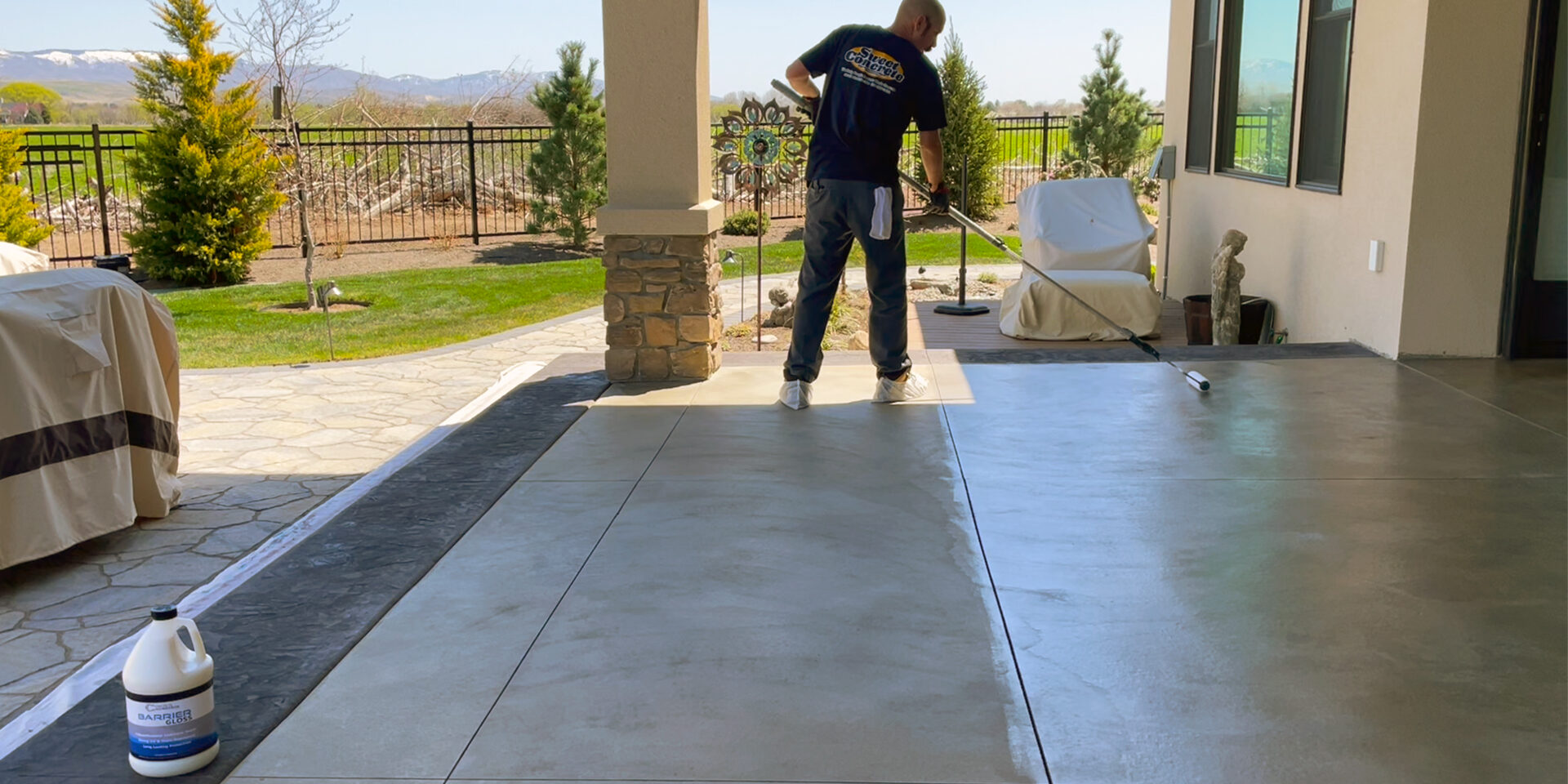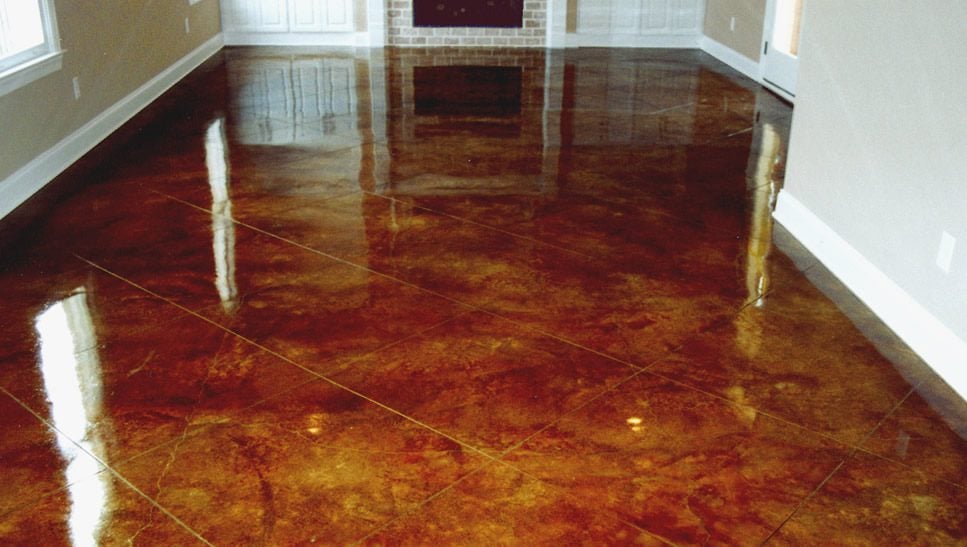How to properly set up for stained concrete projects
Comprehending the Array of Services Offered in Flooring: Highlighting Stained Concrete Techniques
Stained concrete has actually become an engaging flooring option for different spaces. Its adaptability depends on the selection in between acid and water-based stains, each using distinctive aesthetic appeals. Proper prep work and continuous maintenance are vital to ensure its toughness and look. As the need for ingenious flooring services expands, understanding the nuances of tarnished concrete methods might open up brand-new possibilities for both property and industrial atmospheres. What special advantages might this flooring alternative bring to a task?
The Basics of Stained Concrete
Stained concrete works as a functional flooring choice that integrates toughness with aesthetic charm. This flooring strategy entails applying a specifically created stain to the concrete surface, which penetrates and modifies the shade of the material. The process not only boosts the appearances of concrete however also supplies the advantage of securing it from deterioration. Stained concrete can accomplish a broad range of appearances, from natural tones to dynamic colors, making it appropriate for different design styles.
Proper preparation of the concrete surface area is crucial for excellent outcomes. This might include cleansing, grinding, or etching to guarantee the stain adheres properly. Furthermore, the application process generally entails utilizing devices such as sprayers or brushes to attain consistent insurance coverage. After staining, a sealer is commonly related to boost toughness and maintain the vibrancy of the color. Ultimately, tarnished concrete supplies an eye-catching and resilient flooring remedy for residential and industrial areas alike.
Kinds of Stains: Acid vs. Water-Based

On the other hand, water-based spots provide a broader range of colors and are less complicated to apply. They do not react chemically with concrete but instead supply a surface color - stained concrete austin. Water-based discolorations are low in unstable organic compounds (VOCs), making them more eco friendly and suitable for interior jobs. While they might not supply the very same depth of color as acid discolorations, their versatility and simplicity of use make them appealing for different applications. Eventually, the selection depends on the project's demands, desired aesthetics, and location
Methods for Staining Concrete
The strategies for discoloring concrete vary significantly between acid and water-based methods. Acid staining includes a chemical response that develops special, variegated shades, while water-based spots offer a more comprehensive combination and simpler application. Understanding these processes is crucial for attaining the preferred aesthetic in concrete flooring.
Acid Staining Process
Acid staining provides a dynamic way to improve the visual allure of concrete surface areas. This process includes using a blend of water, hydrochloric acid, and pigments to the concrete, which reacts chemically to generate lively, clear shades. The concrete surface needs to be thoroughly cleansed and prepped to assure perfect adhesion. As soon as applied, the acid stain permeates the concrete, creating unique marbled results as it reacts with the lime in the concrete. After the desired shade establishes, the surface is counteracted and washed to halt the response. Finally, a sealant is put on secure the finish and improve longevity. Acid staining not only changes the appearance of concrete yet also gives a long-lasting service for attractive floor covering.
Water-Based Staining Advantages
Just how can water-based staining elevate the visual and practical top qualities of concrete surface areas? Water-based spots provide a functional remedy for improving concrete, supplying dynamic color options while ensuring environmental security. Unlike acid spots, water-based alternatives pass through the surface, permitting even color distribution and a series of finishes, from matte to shiny. Additionally, they are reduced in unpredictable organic compounds (VOCs), making them less damaging to interior air high quality. Their quick drying time promotes much faster project conclusion, while their resistance to fading makes sure durable appeal. Water-based spots can likewise improve the concrete's toughness and resistance to spots, making them a suitable option for both residential and business applications. Inevitably, they offer a sustainable, eye-catching remedy for numerous concrete surface areas.
Layout Opportunities With Stained Concrete
Stained concrete deals a variety of design opportunities that can boost any type of area. Strategies such as shade variation, different surface completing options, and personalized layout patterns enable unique and individualized floor covering remedies. These elements not only elevate looks yet also add to the total capability of the concrete surface area.
Color Variant Methods
While discovering the style opportunities of stained concrete, color variant strategies play an essential role in improving both aesthetic charm and performance. These methods enable the development of distinct patterns and results that can change a basic concrete surface right into a visually striking element of a room. Choices such as acid staining, which reacts chemically with the concrete, produce rich, translucent hues that mimic natural stone. Water-based spots supply a more comprehensive color combination and enable more control in design. Furthermore, layering various spots can develop deepness and measurement, offering a tailored appearance. By integrating shade variation strategies, designers can accomplish varied styles, from rustic to contemporary, ensuring that tarnished concrete fits flawlessly right into any type of style plan.
Surface Finishing Options
The exploration of color variation techniques sets the phase for considering surface area finishing options, which greatly affect the general appearance and performance of stained concrete. Numerous finishes can enhance the aesthetic appeal and toughness of the surface. Usual choices include matte, satin, and shiny coatings, each supplying an unique visual effect. Matte coatings provide a subtle, downplayed elegance, while satin surfaces strike an equilibrium in between shine and usefulness, making them popular for residential and industrial rooms. Glossy finishes, on the various other hand, create a high-shine look, enhancing shade vibrancy and light representation. Furthermore, surface treatments such as sprucing up or securing even more boost longevity, making these finishing options important factors to consider in creating functional and aesthetically appealing discolored concrete floors.
Customized Design Patterns
Just how can custom layout patterns raise the charm of tarnished concrete? By integrating one-of-a-kind designs, discolored concrete can change normal flooring right into a striking visual declaration. Personalized patterns, such as geometric shapes, detailed Go Here themes, or organic styles, enable customization, making areas really feel customized and welcoming. Customers can pick from a variety of techniques, including saw cuts, stencils, or overlays, to accomplish preferred results. Furthermore, integrating several colors with different stain strategies enhances the deepness and measurement of the patterns. These style opportunities not just enhance visual charm however also increase the value of residential or industrial areas. Ultimately, customized design patterns supply an opportunity for creative thinking, setting discolored concrete in addition to standard floor covering options.
Preparing Your Concrete Surface Area
Appropriate preparation of the concrete surface is vital for achieving a successful discolored coating. This process starts with detailed cleaning to eliminate dirt, oil, and any type of various other impurities. A pressure washer my explanation or a flooring scrubber can effectively remove these substances, making certain a fresh start for staining. After cleansing, it is important to repair any kind of fractures or flaws in the concrete. This can be accomplished making use of a concrete patching substance, which need to be allowed to cure completely before proceeding.
When the surface is clean and fixed, grinding or sanding might be needed to create a smooth, even structure. This step boosts the concrete's ability to take in the stain consistently. Lastly, a concrete etcher can be related to open up the pores of the surface area, enabling far better attachment of the stain (Austin stained concrete company). By following these prep work actions, the resulting stained concrete will exhibit a much more vivid and long-term finish
Upkeep and Look After Stained Concrete
Maintaining tarnished concrete is vital for protecting its appearance and long life after the first preparation and application of stain. Regular cleaning is very important; sweeping or vacuuming to get rid of dirt and particles protects against scratches and dullness. For much deeper cleansing, a light pH-neutral detergent mixed with water can be made use of, adhered to by complete rinsing to stay clear of residue build-up.
Securing tarnished concrete is another key upkeep action, as it shields the surface from stains and moisture. Relying on the sealant kind, reapplication may be needed every one to three years. Furthermore, avoiding harsh chemicals and rough devices helps preserve the stability of the stain.
For outside stained concrete, it is recommended to clear snow or ice immediately to stop damage from freeze-thaw cycles. In general, regular treatment guarantees that stained concrete retains its dynamic shade and structural security with time, making it a durable flooring selection.

Expense Considerations for Stained Concrete Floor Covering
When evaluating the expense of discolored concrete floor covering, possible home owners frequently question about the various factors that influence pricing. Key factors to consider include the size of the area to be covered, the complexity of the layout, and the kind of stain made use of. Fundamental staining methods have a tendency to be much more inexpensive, while complex patterns or numerous colors can greatly increase expenses.

Geographic location is another element, as costs can differ widely from one area to another. Continuous maintenance prices must be factored in, as sealers and protective finishes might be necessary over time to protect the visual and longevity of the stained concrete.
Often Asked Questions
Can Stained Concrete Be Applied Over Existing Floor Covering?
The concern of whether tarnished concrete go to my site can be used over existing floor covering is usually asked. Generally, it is feasible, gave the underlying surface area is clean, steady, and suitable for correct attachment of the stained concrete.
The length of time Does the Staining Refine Take?
The staining procedure commonly takes a few hours to a full day, depending on the dimension of the location and the complexity of the style. Treating might require additional time prior to the surface is fully usable.
Is Stained Concrete Suitable for Outdoor Use?
Stained concrete is certainly ideal for outside use, as it stands up to different weather condition problems. Its sturdiness and visual charm make it a preferred selection for patio areas, sidewalks, and driveways, boosting both capability and visual rate of interest.
Can I Change the Color of Stained Concrete Later?
The capability to transform the color of discolored concrete later on depends upon various aspects, consisting of the original stain kind and surface preparation. Consulting a specialist can supply support on potential options and outcomes for color modification.
Exist Eco-Friendly Options for Stained Concrete?
The questions regarding green alternatives for discolored concrete reveals a growing rate of interest in sustainable structure practices. Many companies now offer low-VOC discolorations and environmentally friendly sealants, guaranteeing visual appeal while reducing environmental impact.